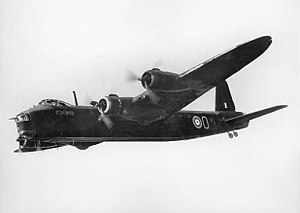| Stirling | |
|---|---|
 Short Stirling Mk.I W7459 'O' of No. 1651 HCU (Heavy Conversion Unit) in flight, 1942 | |
| General information | |
| Type | Heavy bomber Glider tug |
| National origin | United Kingdom |
| Manufacturer | Short Brothers, Rochester Short Bros. and Harland, Belfast Austin Motor Company |
| Designer | Claude Lipscomb / Sir Arthur Gouge |
| Status | Retired |
| Primary users | Royal Air Force |
| Number built | 2,371[1][2] |
| History | |
| Manufactured | 1939–1945 |
| Introduction date | 1940 |
| First flight | 14 May 1939 |
| Retired | 1946 (UK); 1951 (Egypt) |
The Short Stirling was a British four-engined heavy bomber of the Second World War. It has the distinction of being the first four-engined bomber to be introduced into service with the Royal Air Force (RAF) during the war (the earlier Handley Page V/1500 being a WWI design that served during the 1920s).
The Stirling was designed during the late 1930s by Short Brothers to conform with the requirements laid out in Air Ministry Specification B.12/36. Prior to this, the RAF had been primarily interested in developing increasingly capable twin-engined bombers, but had been persuaded to investigate a prospective four-engined bomber as a result of promising foreign developments in the field. Out of the submissions made to the specification, Supermarine proposed the Type 317, which was viewed as the favourite, whereas Short's submission, named the S.29, was selected as an alternative. When the preferred Type 317 had to be abandoned, the S.29, which later received the name Stirling, proceeded to production.
In early 1941, the Stirling entered squadron service. During its use as a bomber, pilots praised the type for its ability to out-turn enemy night fighters and its favourable handling characteristics, whereas the altitude ceiling was often a subject of criticism. The Stirling had a relatively brief operational career as a bomber before being relegated to second-line duties from late 1943, due to the increasing availability of the more capable Handley Page Halifax and Avro Lancaster, which took over the strategic bombing of Germany. Decisions by the Air Ministry on certain performance requirements (most significantly to restrict the wingspan of the aircraft to 100 feet [30 m]) had played a role in limiting the Stirling's performance; the 100 ft limit also affected earlier models of the Halifax (MkI and MkII) though the Lancaster never adhered to it.[3]
During its later service, the Stirling was used for mining German ports; new and converted aircraft also flew as glider tugs and supply aircraft during the Allied invasion of Europe in 1944–1945. In the aftermath of the Second World War, the type was rapidly withdrawn from RAF service, having been replaced in the transport role by the Avro York, a derivative of the Lancaster that had previously displaced it from the bomber role. Several ex-military Stirlings were rebuilt for the civilian market.